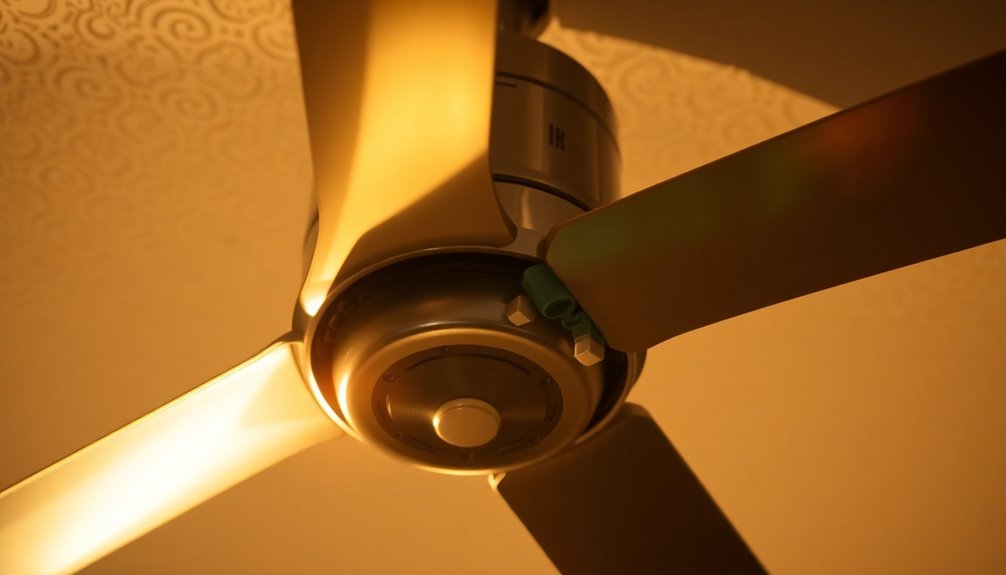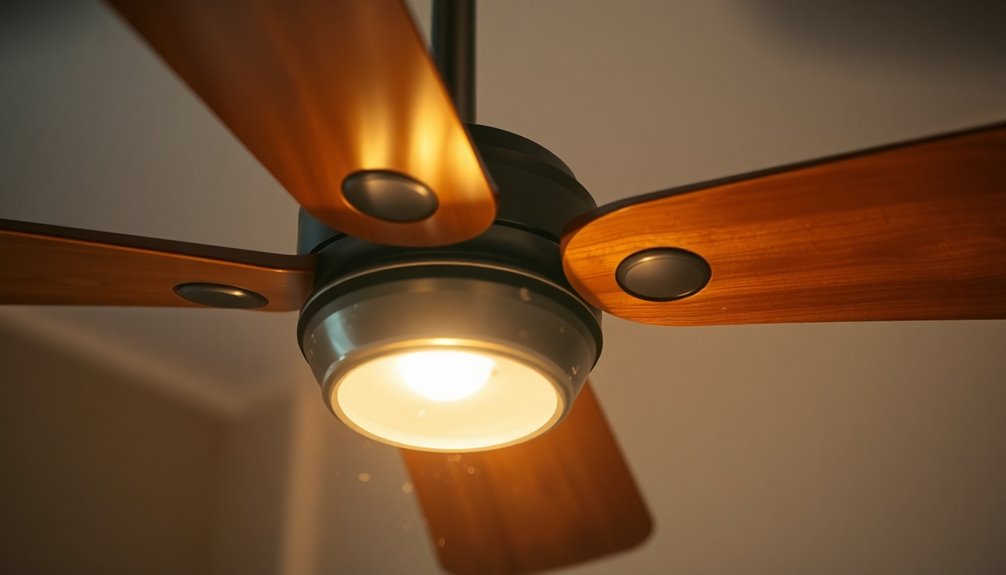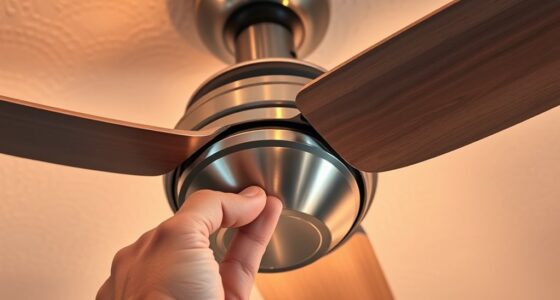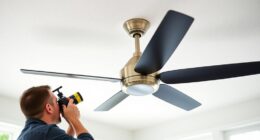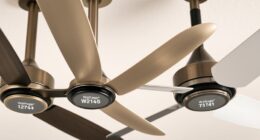Your ceiling fan might be making noise due to several issues. Loose screws can cause rattling sounds, while unbalanced blades lead to humming or buzzing. If the motor bearings are worn or dirty, you may hear grinding or squeaking. Poor installation can also result in various noises from misalignment. If tightening screws and cleaning don't help, you might be facing deeper electrical issues. Regular maintenance can keep your fan quiet and efficient. There's more to discover about potential solutions and when it might be time to call in a professional.
Key Takeaways
- Loose components, such as screws or blades, can create rattling or clicking noises in your ceiling fan.
- Unbalanced blades may cause humming or buzzing due to vibrations and misalignment.
- Worn or dirty motor bearings typically produce grinding or squeaking sounds, indicating a need for cleaning or replacement.
- Electrical issues, like loose wiring or failing motors, often manifest as loud humming or buzzing noises.
- Improper installation can lead to various noise types, highlighting the importance of secure mounting and alignment.
Common Causes of Noise

Ceiling fans can be a great addition to your home, but when they start making noise, it can be frustrating. One common culprit is loose screws in the fan assembly. These can create rattling or clicking noises, so it's a good idea to check and tighten them regularly.
Unbalanced blades can also lead to vibrations and a persistent hum or buzz, as the fan struggles to operate smoothly.
Another issue could be worn or dirty motor bearings, which often produce grinding or squeaking sounds. If you notice this, you might need to lubricate or replace the bearings to restore quiet operation.
Electrical issues, like faulty wiring or a failing motor, can manifest as a loud hum or buzz, and these should be addressed immediately to avoid safety hazards.
Lastly, improper installation can cause misalignment, leading to various noise types, including rattling or clicking.
Regular maintenance is key to keeping your ceiling fan operating quietly. By identifying these common causes of noise, you can take the necessary steps to guarantee your ceiling fan remains a peaceful addition to your home.
Types of Ceiling Fan Noises

When your ceiling fan makes noise, it's important to identify the type of sound you're hearing.
Different noises can point to either mechanical issues, like loose parts, or electrical problems that might need immediate attention.
Understanding these noise types helps you troubleshoot and resolve the issue effectively.
Common Noise Types
Understanding the various sounds your ceiling fan makes can be essential for maintaining its efficiency and safety. Noise types can provide clues about potential issues, helping you diagnose whether you're dealing with mechanical or electrical problems.
| Noise Type | Possible Cause | Action Needed |
|---|---|---|
| Clicking Noise | Loose blades or light fixture | Tighten screws, check for damage |
| Humming or Buzzing | Electrical issues | Investigate wiring, motor |
| Rubbing Noise | Misaligned parts, lack of lubrication | Realign, lubricate parts |
| Crackling or Sizzling | Serious electrical problems | Immediate inspection needed |
| Grinding | Worn-out bearings | Replace bearings |
| Squeaking | Dry parts or misalignment | Lubricate or adjust |
| Rattling | Loose components | Tighten or secure |
Mechanical Noise Indicators
Noises from your ceiling fan can be more than just an annoyance; they often signal underlying mechanical issues that need attention.
For instance, if you hear clicking sounds, it's likely due to loose blades or components. Make sure to inspect and tighten any loose screws or check for signs of damage in the blade arms.
Humming or buzzing can indicate electrical issues, but if you notice this alongside other sounds, it might be worth investigating further.
Grinding or squeaking noises typically arise from dirty or damaged bearings, signaling increased friction and the need for cleaning and lubrication.
Rattling noises often result from loose screws or improperly secured components. You can resolve these sounds by inspecting and tightening all connections within the fan assembly.
Additionally, if you experience rubbing noise, this might suggest misalignment or insufficient lubrication, requiring adjustments to prevent continued noise during operation.
Electrical Noise Causes
Mechanical issues aren't the only culprits behind ceiling fan sounds; electrical problems can also create a range of noises that signal potential issues. Humming noises often indicate electrical issues, particularly related to a failing motor or loose wiring connections. These sounds can become more pronounced when the fan is connected to dimmer switches.
Buzzing sounds may arise from electromagnetic interference, where the fan's motor creates vibrations through the electrical system, possibly indicating worn motor windings.
If you hear crackling or sizzling noises, take them seriously; these typically signify faulty wiring or electrical shorts that require immediate inspection to prevent fire hazards. Clicking noises might be due to loose electrical connections or components within the fan's light kit, signaling you need to tighten screws or fittings for proper function.
Consistent buzzing or humming may also suggest a mismatch between the fan's electrical requirements and the circuit it's connected to. If you encounter any of these issues, don't hesitate to seek a professional evaluation to guarantee your ceiling fan operates safely and efficiently. Ignoring these sounds can lead to more significant problems down the line.
Fixing Noisy Ceiling Fans

If your ceiling fan is making noise, the first step is to identify the source of the sound.
You can implement quick fixes, like tightening loose screws or cleaning the blades, to see if that helps.
Addressing these issues can greatly reduce unwanted noise and improve your fan's performance.
Identify Noise Source
When troubleshooting a noisy ceiling fan, the first step is to turn it on and listen closely to locate the source of the sound. You should try to identify the noise source by determining whether it's coming from the ceiling fan blades, the motor housing, or perhaps the light fixture.
Begin by inspecting the fan blades for any wobbling or misalignment, as loose components can cause rattling or clattering noises during operation.
Next, examine the motor housing and mounting bracket for any visible damage or wear that could lead to grinding or squeaking noises. Use a flashlight to check those hard-to-reach areas for dirt buildup or debris that might be causing friction and contributing to the noise.
If you notice any issues, take note of them and consider whether the noise persists after these checks. If the fan continues to be loud, it might be necessary to address weight distribution issues using a balancing kit.
Implement Quick Fixes
After pinpointing the noise source, you can implement some quick fixes to silence your ceiling fan. Start by inspecting and tightening any loose parts, as these are common causes of rattling and clicking noises. Make certain to secure the blades properly to prevent further noise issues.
Regular maintenance is key, so clean the fan blades and motor housing to remove dust and debris. This will not only reduce operational sounds but also guarantee smooth operation. If you hear humming or buzzing, check the electrical connections and secure any loose wiring.
Using a balancing kit can help adjust unbalanced blades, greatly reducing wobbling and related noises. Additionally, lubricate the motor bearings annually to avoid grinding or squeaking sounds, which can prolong the lifespan of your ceiling fan.
Here's a quick reference table to help you with these fixes:
| Quick Fix | Description | Frequency |
|---|---|---|
| Inspect and Tighten | Check screws on blades and motor assembly | Monthly |
| Clean Fan Blades | Remove dust and debris from blades | Monthly |
| Secure Electrical Wires | Guarantee all connections are tight | As needed |
| Use Balancing Kit | Adjust unbalanced blades | As necessary |
| Lubricate the Motor | Apply lubricant to motor bearings | Annually |
Diagnosing Motor Issues

While diagnosing motor issues in your ceiling fan, it's important to pay attention to any unusual noises like humming or buzzing, as these can signal underlying problems. A humming sound often indicates a malfunctioning capacitor, which can hinder motor performance and lead to additional noise.
Listen closely to identify the specific sound, as this can help you pinpoint the issue.
If your fan creates vibrations, it may be due to misalignment or loose connections. These vibrations can amplify noise and indicate that components need tightening or adjustment.
Regular maintenance is key to preventing such issues; make certain you lubricate motor bearings to reduce friction and wear, which can also contribute to noise.
If you notice persistent humming or buzzing, it may suggest electrical failure or worn motor windings, requiring further investigation. In such cases, a professional inspection might be necessary to determine if repairs or replacement are needed.
Addressing Installation Problems

Proper installation of your ceiling fan is vital for minimizing noise and ensuring ideal performance. First, make sure the mounting bracket is securely fastened to the ceiling. A loose bracket can cause wobbling and vibrations, leading to unwanted noise during fan operation.
It's also essential to verify the compatibility of your fan's mounting system with your ceiling type and height to avoid installation-related noise issues.
When you install the fan, check that all electrical connections are secure to eliminate buzzing or humming sounds from loose wiring. Maintaining consistent blade height during installation is equally important; any imbalance can greatly increase noise levels.
Additionally, assess the installation height of the fan. Positioning it correctly not only minimizes vibrations but also enhances airflow efficiency.
Maintenance Tips for Quiet Operation

Once you've confirmed your ceiling fan is installed correctly, regular maintenance becomes key to keeping it quiet and efficient.
Start by tightening the screws and bolts on both the fan and blades. Loose components can create rattling noises, which can be easily avoided.
Next, make it a habit to clean the fan blades and motor housing at least every few months. Dust accumulation can lead to operational sounds and reduced efficiency.
Don't forget to lubricate the motor bearings annually. This reduces friction and helps guarantee smooth operation, minimizing noise.
Additionally, periodically inspect the motor for signs of wear or damaged parts, such as warped fan blades or loose mounting brackets. Addressing these issues early can prevent them from escalating into noise problems.
To maintain balance, use a blade balancing kit to check and adjust the blade balance regularly. Ensuring even weight distribution will notably reduce vibrations and noise during operation.
Following these maintenance tips will keep your ceiling fan running quietly and efficiently, enhancing your overall comfort at home.
When to Seek Professional Help

Noise can be a frustrating issue with ceiling fans, and knowing when to seek professional help is essential for your peace of mind. If you've tightened screws and the noise persists, it may signal deeper issues that need expert assessment. Regular maintenance can help identify potential problems before they escalate, similar to how keeping Ring Doorbell charged ensures optimal performance.
| Signs to Seek Help | Action |
|---|---|
| Notable wobbling | Consult a professional for balancing |
| Signs of smoke or burning smells | Immediate professional consultation |
| Electrical problems (faulty wiring) | Hire a licensed electrician |
| Repairs involving motor replacement | Seek specialized assistance |
Complex electrical problems, like faulty wiring or malfunctioning capacitors, should always be handled by a licensed electrician for safety. If your fan wobbles notably despite your DIY efforts, it's time to call in an expert. Additionally, any signs of smoke, burning smells, or crackling noises warrant immediate attention to prevent fire hazards. Remember, repairs involving the motor or intricate installations require specialized tools and expertise, making professional help the safest choice for your ceiling fan issues. Don't compromise on safety; reach out for help when needed. Regular maintenance checks on your ceiling fan can help prevent these issues before they escalate.
Frequently Asked Questions
How Do I Stop My Ceiling Fan From Making Noise?
To stop your ceiling fan from making noise, start by tightening all screws and components.
Clean the blades and motor to remove dust that disrupts balance.
Lubricate the motor bearings annually to prevent squeaks.
Use a blade balancing kit to guarantee all blades are evenly weighted, minimizing vibrations.
Finally, inspect for any damaged or warped blades and replace them to guarantee smooth operation, leading to a quieter fan experience.
Why Does My Fan Make a Noise When Spinning?
When your fan spins, it might make noise due to several reasons.
Loose screws can cause rattling, while unbalanced blades lead to vibrations and buzzing.
If the motor bearings are dirty or damaged, you could hear grinding or squeaking sounds.
Mechanical issues, like misaligned parts, create rubbing noises.
Finally, electrical problems, such as faulty wiring, can result in unusual humming.
Identifying the cause can help you fix the issue effectively.
Should I Be Worried if My Fan Is Making Noise?
If your fan's making noise, you should definitely pay attention. It can indicate something's wrong, and ignoring it might lead to bigger issues.
Loose screws might cause rattling, while humming could signal electrical problems. Mechanical noises often hint at misalignment or insufficient lubrication.
Don't dismiss persistent or unusual sounds, as they could pose safety hazards. Regular maintenance and prompt action can keep your fan running smoothly and safely for years to come.
How to Stop Fan Bearing Noise?
To stop fan bearing noise, start by cleaning the bearings regularly to remove dust and debris.
Lubricate them annually with the manufacturer's recommended lubricant to reduce friction.
Inspect for any signs of damage like pitting or scoring—if you find any, consult a professional for replacement.
Establish a routine maintenance schedule to guarantee everything runs smoothly and quietly.
Conclusion
To sum up, a noisy ceiling fan can be as pesky as a gnat buzzing around your ear. By identifying the common causes and addressing installation and motor issues, you can restore peace to your space. Regular maintenance will help keep your fan running smoothly and quietly. If the noise persists despite your efforts, don't hesitate to reach out to a professional. After all, a little help can go a long way in ensuring comfort at home.
